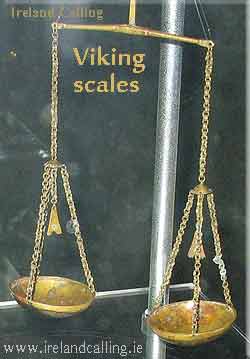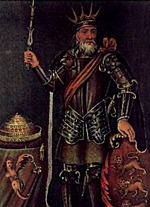the_Vikings_in_text.html
The Vikings arrived in Ireland in the late 8th century. Over the next several decades they settled in the country and built towns which would grow to become the major Irish cities of today. Their key settlement was Dublin.
While Viking invaders had built settlements in Ireland, other Viking groups had established control in areas of the north of England and the Isle of Man. Dublin became an important trading centre.
The Vikings in Ireland and Britain developed successful trading channels between the two islands. Products included jewelry, wool and animal hides. The slave trade was also prevalent with slaves being both imported and exported.
The Vikings’ control over Dublin came to an end in 902 when they were forced out by the Irish clans. It is possible that it was only the leading classes of the Vikings who were exiled, with the Irish happy to allow the tradesmen to stay.
Vikings returned stronger

The Vikings fled to Britain where they discovered new possibilities from the advanced towns that had developed in England and Wales.
They returned to Ireland in 917 and regained control of Dublin. They built a stockade around the town and the community lived inside the walls. It was no longer simply a longphort, it was now a fortification, providing security for its residents.
The conflict between the Vikings and the Irish continued and in 936, the Irish burned Dublin to the ground. However, the Vikings were more resilient this town and rebuilt their town.
As the 10th century progressed, the Irish and Vikings formed many temporary alliances as they pursued various ambitions. It wasn’t uncommon for intermarriages between the two races as clans and families looked to strengthen alliances and therefore their power.
The Gaelic by far outnumbered the Norse and as the decades passed by they became better organised and politically more powerful having learned from the Vikings. The Uí Néill King Máel Seachnaill captured Dublin in 980. A power struggle between the Uí Néill and the Vikings ensued. The following ten years saw the Uí Néill lose control of Dublin but recapture the town again in 990.
Brian Boru and the Battle of Clontarf

However, it was Dál gCais King Brian Boru who was about to take control of the country. Brian manoeuvred himself into such a strong position that Máel had to surrender to him. Brian became High King but was constantly under threat from minor kings. It led to the Battle of Clontarf in which Brian led his men against the King of Leinster, who was supported by Viking forces.
Brian won the battle but he was killed, as was his son and grandson. The Dál gCais gradually lost their power following the battle. The Vikings also became a lesser force and eventually lost control of Dublin in the mid-11th century. The Vikings continued to integrate with the native Irish and eventually became Christian. Ireland went back to being a country ruled by several small kingdoms, with no one taking full control.

the_Vikings.html